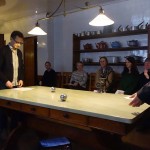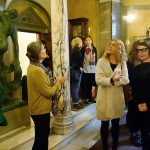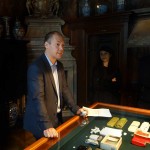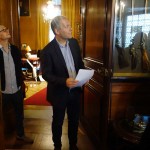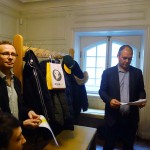- A performative guided tour of Hallwylska museet by Per Hüttner and Elias Arnér, 6 February, 2015 – part of The Fugue, OuUnPo Research Session XIV.
The project took the form of a guided walk through the Hallwyl Palace in central Stockholm. Each group of roughly 20 visitors were lead into the kitchen where Hüttner and Arnér were waiting on either side of the large table. Arnér gave a brief introduction to the project and when he finished, he rolled a heavy ball across the table producing an unexpected sound. Huttner responded:
“Every day we take decisions about what we eat. We can change our eating habits with the hope to improve our health or appearance. But in the end thousands of micro-decisions taken in super markets and staring into our open fridges define physically who we are – since the molecules that make up our food are metamorphosed into our bodies. In other words it is totally logical to start this Fugue in the kitchen.”
The two talked about fasting, hunger-strikes and other aspects related to food, eating and decision-making and rolling the ball back and forth. The group moved up the back staircase through the sleeping rooms and the armoury and ended up at the pool table. Hüttner and Arnér placed them selves in a similar position as in the kitchen. Arnér started speaking:
” ‘Chance’ is an interesting word. It can, of course, suggest that we have a ‘chance’ to accomplish something at a certain moment, but it can also denote that what we do or what we experience just happens by ‘chance,’ i.e. randomly. Or would our choices perhaps always be random?”
He then rolled the ball across the table that is covered by glass – again creating another unexpected sound. Hüttner responded by talking about a wide variety of topics including John Cage and Dinosaurs. The group then moved back into the armoury. Per started talking around “what we decide to fight for.” When he finished, he rolled a marble down the staircase. Elias responded and when he had finished he also rolled a marble down the stairs.
“What do you think – is an object important or valuable only because of the meaning we give to it, or can it have an inherent value? And, is it only through our observations and interpretations of these particular pieces of armour that they may become valuable, or would they still be valuable if we couldn’t see them? This is actually us right now living the Schrödinger dilemma, i.e. that (quantum particles and phenomena) are only there once they are observed – and by observing them we change them. What would you say, Per – could a piece of art be valuable, even if nobody would ever see it?”
The group walked through the most elaborately decorated rooms in the Palace and down the stairs into the locker room. The two reflected what we decide to keep, which is in keeping with the locker room and the museum. While Arnér was talking, Hüttner opened lockers that are filled with balls of different sizes and shapes that rolled onto the floor and bounced around the space..
Video by Fabien Guillermont

